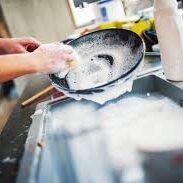Hand Washing dishes doesn’t have to be a chore. With the right steps and a little know-how, you can get sparkling clean results every time. Whether you prefer using diluted soap in a sink of water or applying detergent directly to a sponge (the “neat” method), the key is to follow product instructions especially for concentrated detergents.
Before you begin, always check if any of your cookware, like air-insulated baking pans, should be kept out of water. When in doubt, refer to the manufacturer’s instructions.
Step 1: PREP – Scrape & Soak
Start by scraping off leftover food with a rubber spatula or paper towel. For stubborn, stuck-on messes, pre-soak dishes by adding detergent or baking soda and filling the sink or pot with hot water. Let it soak for 15–30 minutes.
Tip: Never pour grease down the drain, it can clog your pipes.
Step 2: FILL – Add Hot, Soapy Water
Fill your sink or dishpan with clean, hot water and add the correct amount of dish soap (check the label). Load a few dishes at a time, this gives them a chance to soak while you wash others.
Tip: If the water gets greasy, cool, or loses suds, drain and refill the sink.
Step 3: WASH – Clean from Light to Heavy
Wash dishes in order of how dirty they are:
Start with lightly soiled items like glasses, cups, and cutlery.
Move on to plates, bowls, and serving dishes.
Finish with pots and pans, especially those that were soaked.
Keep dishes under the water as you scrub, lifting them occasionally to check for missed spots.
Tip: Wash kitchen knives separately and carefully. Do not pile them in the sink—clean one at a time and place them safely in a rack or lay them flat to dry.
Step 4: RINSE – Remove Suds & Residue
Use clean, hot water to rinse off soap. If you have a double sink, reserve one side for rinsing. You can also rinse under running water or pour hot water over dishes placed in the drying rack.
Tip: Make sure to rinse inside glassware and bowls thoroughly.
Step 5: DRY – Air or Towel Dry
Air drying is the easiest method and helps avoid spots. For glassware or flatware with residue or water spots, use a clean towel. Paper towels are ideal for drying greasy pots and pans.
Tip: Use a fresh towel and replace it if it becomes damp. Sponges and cloths should be rinsed, air-dried, or washed after use and replaced regularly.
Wrap-Up: Clean Space, Clear Mind
Once the dishes are done, take a few minutes to clean up. Rinse and wipe the sink, dishpan, and drainer. Leave clothes and sponges to air dry, or toss them in the wash. A clean kitchen setup today makes tomorrow’s dishwashing that much easier!







